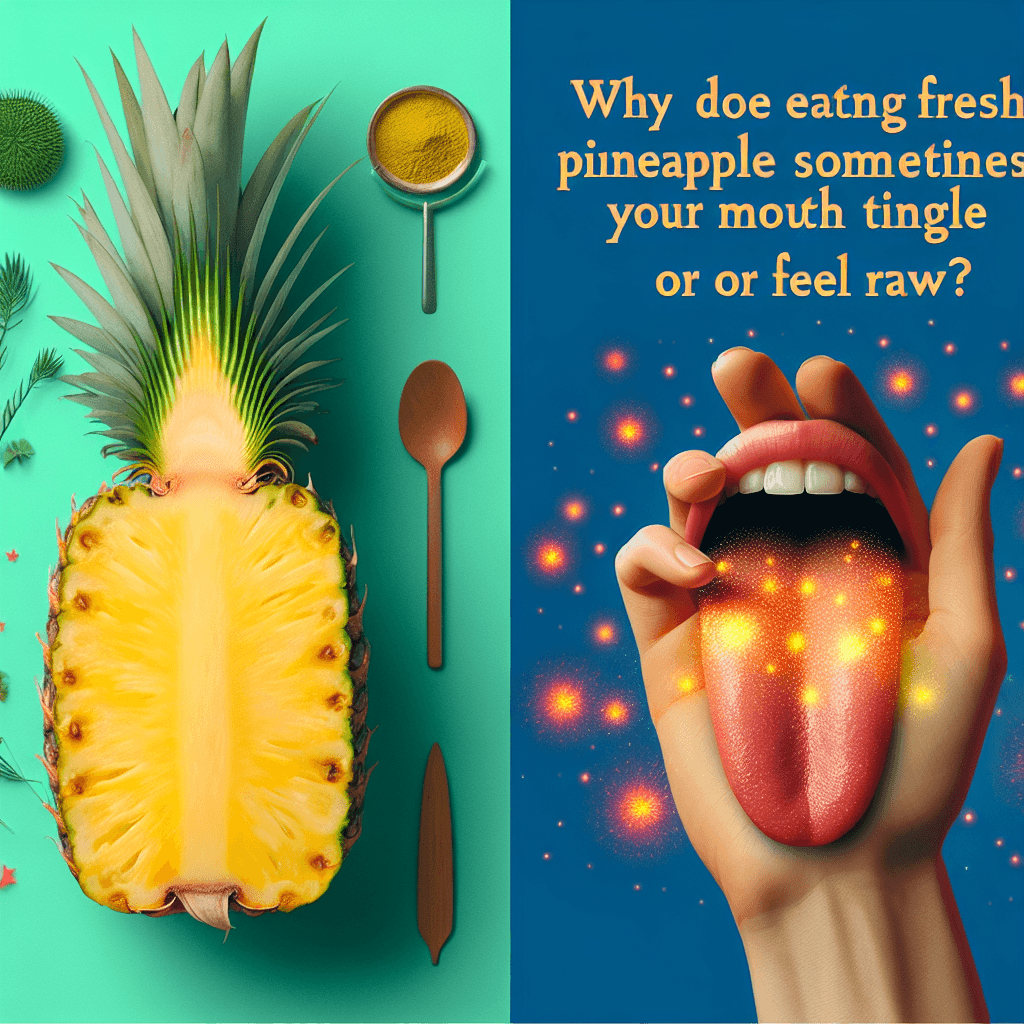Why does eating fresh pineapple sometimes make your mouth tingle or feel raw
That tingling, raw sensation you get from fresh pineapple isn't just your imagination. Discover the fascinating, and slightly unsettling, reason why this tropical fruit is literally eating you back.


Too Long; Didn't Read
Fresh pineapple contains bromelain, an enzyme that digests protein. That tingling sensation is the enzyme breaking down the surface of your mouth. Essentially, the fruit is eating you back.
Pineapple's Prickly Secret: Why Does Eating Fresh Pineapple Sometimes Make Your Mouth Tingle or Feel Raw?
You’ve just bitten into a perfectly ripe, juicy slice of fresh pineapple. The initial burst is sweet and tropical, but a few chews later, a strange sensation begins. Your tongue starts to tingle, your gums feel a little raw, and the roof of your mouth feels strangely tender. If this sounds familiar, you're not alone, and you’re likely not having an allergic reaction. This common and peculiar phenomenon is a fascinating bit of food science at work. This post will break down exactly why that delicious pineapple seems to "bite back" and explore the biochemical culprit behind the prickle.
The Main Culprit: Meet Bromelain
The tingling or raw sensation you experience when eating fresh pineapple is caused by a powerful enzyme complex called bromelain.
Bromelain is a type of protease, which is an enzyme specifically designed to break down proteins. In the pineapple plant, bromelain serves as a defense mechanism, helping to deter pests and aiding in the decomposition of fallen fruit. When you eat the pineapple, this same enzyme gets to work inside your mouth. In essence, as you are eating the pineapple, its enzymes are starting to digest the delicate protein-rich tissues on the surface of your tongue, lips, and inner cheeks. This enzymatic action is what causes that signature tingling, burning, or raw feeling.
Think of it this way: bromelain is such an effective protein-buster that it's extracted and sold commercially as a meat tenderizer. The reason it works so well to soften a tough cut of steak is the same reason it makes your mouth feel tender.
So, Why Doesn't Canned Pineapple Do This?
You might have noticed that this prickly sensation is exclusive to fresh or frozen pineapple. You can eat an entire can of pineapple chunks or drink pasteurized pineapple juice without any discomfort. The reason lies in how enzymes react to heat.
The canning and pasteurization processes involve heating the pineapple to high temperatures to kill bacteria and preserve the fruit. This heat denatures the bromelain enzyme, which means it changes its molecular structure and deactivates it. Once denatured, bromelain can no longer break down proteins, leaving you free to enjoy the pineapple tingle-free. The same logic applies to cooked pineapple, which is why grilled pineapple or pineapple on a pizza is always mild.
Is It an Allergy? Distinguishing Irritation from an Allergic Reaction
For most people, the tingling is simply a temporary irritation caused by bromelain. However, a true pineapple allergy does exist, though it is less common. It's important to know the difference.
- Bromelain Irritation: A mild, localized tingling, soreness, or raw feeling in the mouth that subsides shortly after you stop eating.
- True Allergic Reaction: Symptoms are more systemic and severe. They can include skin reactions like hives or rashes, significant swelling of the lips, tongue, or throat, abdominal pain, vomiting, or difficulty breathing.
If you experience any symptoms beyond a temporary mouth tingle, you should stop eating the fruit and consult a medical professional.
Tips to Tame the Tingle and Enjoy Your Pineapple
Understanding the science behind the prickle also gives us the tools to minimize it. If you love fresh pineapple but not the after-effect, try these simple tips:
- Choose Ripe Fruit: Bromelain concentration is highest in the less-ripe parts of the fruit, especially the core and stem. A fully ripe, golden-yellow pineapple is not only sweeter but also tends to be less aggressive.
- Avoid the Core: The woody core contains the highest levels of bromelain. Stick to the softer, sweeter flesh.
- Pair with Dairy: Eating pineapple with yogurt, ice cream, or cottage cheese can help. The bromelain will get to work breaking down the proteins in the dairy (casein), giving your mouth a bit of a break.
- Soak in Salt Water: A light soak in salt water before eating is a folk remedy that many swear by. The salt can help to alter the pH and partially denature the enzymes on the fruit's surface.
Conclusion
That prickly sensation from fresh pineapple isn't just your imagination; it's a direct result of the powerful protein-digesting enzyme, bromelain, breaking down the surface cells in your mouth. This natural component is a testament to the complex biochemistry present in the food we eat every day. While it might feel like the pineapple is fighting back, this process is harmless for the vast majority of people. Now that you know the secret behind pineapple's prickle, you can use a few simple tricks to manage the sensation and continue to enjoy this wonderfully sweet and tangy tropical treat.


